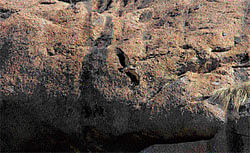
While on our way to Bandipur one sunny morning, we decided to visit Ramadevara Betta in Ramanagara to see the critically endangered long-billed vultures. As we always do, we climbed up to the top of the hillock facing the cliff where the vultures were nesting and sat with our binoculars glued to our eyes watching the birds busily arranging the bedding material of their nests.
Our excited discussion about these birds as they soared above our heads was rudely interrupted by the sounds of a powerful drill. We located the origin of the sound and could not believe our eyes. Two rock climbers were drilling pitons adjacent to cliff face where the vultures were nesting.
Having worked with birds at close quarters we have witnessed the stress they go through even with the slightest disturbance. We wondered as to what kind of an effect this loud noise, along with the vibration, would have on these birds. A horned owl and a pair of nesting Shaheen falcons were also spotted in a hollow on the cliff face. Owls are extremely sensitive to sound as they are dependent on hearing to look for their prey.
From a human being’s perspective, the drilling may not be too loud to affect the ears, but for an owl it definitely was too loud.
The following week we visited Ramadevara Betta again and noticed that this time it was the photographers with their huge cameras standing right under the ledges where the birds nest for many hours to get the best picture. Wildlife photography is important to conserve wildlife, but when it reaches a stage where it is used to satisfy one’s ego, does wildlife have a chance? There are already excellent, well-documented pictures of long-billed vultures. Is there a necessity for every other photographer to disturb these birds to get a good shot? Is publicity so very important compared to the survival of these species?
What’s driving the birds away?
Once widespread across India, the population of vultures has dropped drastically since the 1990s. At one point, long-billed vultures at Ramadevara Betta were in trouble because there was a plan to build a commercial resort right under the nesting site.
Thanks to the efforts of a few birdwatchers and environmentalists, construction was stopped.
But, if the resort eventually comes up, what that could do to the future of these birds is hard to say. There are also other threats that may not be apparent. Vultures need lots of food and they prey on animal carcasses in and around the villages, but with urbanisation creeping in the landscape around Ramadevara Betta, the vultures might have to go further away to look for food. Would this along with disturbance at the nest site drive the birds away? But who will save these birds from people who travel in their cars just to have some fun during the weekend and talk about how much they know about wildlife? Sections of urbanites have the habit of pointing fingers at villagers or tribals, blaming them for chopping trees and hunting wildlife.
Is it even vaguely apparent to these climbers and photographers that their self-centered activities could push these magnificent birds into extinction? Interacting with a local boy who has been watching these birds for more than ten years we were informed that the weekends are extremely stressful for the birds as photographers and climbers keep disturbing them. Why can’t these photographers learn from some of the well known photographers who are extremely sensitive towards wildlife?
Sitting on the opposite hillock one can definitely get a very good view of these birds and yet cause them minimal stress. It is high time we become sensitive and start respecting these efficient scavengers. Maybe then, closer to home we could make small but effective changes in the way we live and the way we interact with our environment. The recent announcement by the Forest Department to turn this into a vulture sanctuary is a great relief. We only hope that this includes the protection of a larger area around Ramadevara Betta. It is also necessary to bring in regulations to handle the influx of tourists.
(The authors are with the Ashoka Trust for Research in Ecology and the Environment, Bangalore.)